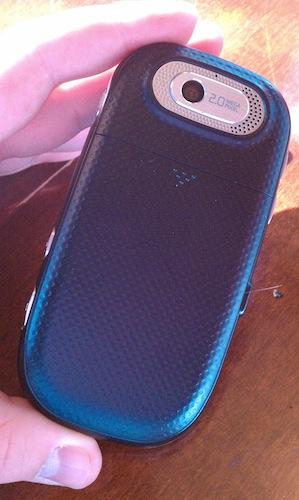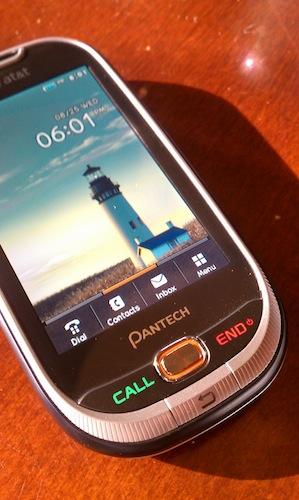
The Good: Easy menu and roomy physical keyboard makes this a choice for more than one demographic.
The Bad: Lackluster 2.0-megapixel camera.
The Verdict: With an easy to use menu and physical QWERTY keyboard, the Pantech Ease is a nice device that will appeal to casual phone users and text addicts alike.
In the past few years, we've seen several devices launch that are targeted towards an older demographic. The Pantech Ease, available at AT&T, is a unique hybrid device. It's a design that, while optimized for older individuals, works well for first-time phone owners and texting teens. For what some would consider a low-end featurephone, the Ease offers the best of both worlds - a nice 3.2-inch touchscreen and a physical keyboard. With two menu modes - easy and advanced - it's as if the Ease lives two lives. All in all, it's a solid featurephone, and is worthy of consideration.
Design & Features

Inside of the box, you get the device, battery, AC adapter module, USB cable, and instruction manuals. Sadly, the Ease has no native headphone jack, so if you're interested in using a headset, you'll need to purchase an adapter. Coming in at 4.48 inches long by 2.28 inches wide by 0.56 inch thick, the Ease weighs 4.86 ounces, making it reasonably easy to carry in a pocket or glove compartment box.
The left side of the device contains the volume rocker and microUSB charging port, and the right side houses the lock toggle, voice dial shortcut, and the camera button. The front of the device houses four physical buttons: Send, End, Back, and "Quick Contacts," which allows you to program in three frequently dialed numbers. The microSD card slot, which supports up to 16 GB, is located behind the battery door. Slide the device to the right to find the physical QWERTY keyboard.

In addition to the typical wallpaper and ringtone changes, the actual user interface offers a nice level of customization. There are three home screens, two of which are customizable. You can place app shortcuts on one, and contact shortcuts on another. For those with poor vision, the text size can be enlarged.
Pantech offers an "easy" and "advanced" menu structure, depending on your personal preference. Some of the available apps change depending on the menu mode you're in. For example, when in "easy" mode, pedometer and pill reminder apps are available. When you switch to "advanced" mode, you get the notepad, AT&T Music, Where, Loopt, and the other data-centric programs installed on the device. On the surface, it makes sense, though the delegation confused me at times.

The physical keyboard is incredibly roomy and easy to use. The keys are oval-shaped and spaced well, and Pantech reserved a dedicated row for the space bar and symbols. Within a few minutes, I was sending messages with ease. If the keyboard doesn't tickle your fancy, you can also use the on-screen T9 one.
The Ease offers a 2-megapixel camera that is decent enough for anyone that wants to take a quick picture on the go. You can geotag the photos, along with the ability to adjust the white balance, color effect, self timer, picture size, quality, and more. My personal favorite was "Face Effects," which gives you 11 different ways to take a picture of your face (think Photo Booth). The video camera was sufficient, but grainy in my testing. Good for catching a video on the go, but not for anything beyond that.
Overall call quality was great, and the earpiece was nice and loud. Pantech offers "Dynamic Noise Suppresion" with the Ease, and callers noticed the difference. I tested the speakerphone at a busy Starbucks, and was able to hear my caller over the hustle and bustle. I paired my Plantronics Voyager Pro to the Ease, and callers were unable to tell that I was using a Bluetooth headset.
Interestingly enough, regardless of where I was in the area, I was unable to get more than three or four bars of service (the maximum is five). I live right beside an AT&T cell site, and while other AT&T devices usually display full service, I was unable to get more than four bars of service on the Ease. Signal strength indicators can be tricky at times, but I found this to be particularly interesting. It wasn't completely representative of call quality, tough: I took the device to an AT&T dead zone just outside of the city, and though the device was fluctuating between zero and one bar of service, was able to complete two test calls without any issue. All in all, my voice experience was very good - the indicator is just a bit funky.

The Ease is powered by a 1,000 mAh battery, and with moderate use - calling, text messaging, occasional web browsing, and use of some of the included apps, I was able to make it just under two days before the battery died. With light use, the Ease could easily (no pun intended) make it 2-3 days before requiring a charge. As usual, I recommend carrying a car charger in case of emergencies, but the battery should last quite a while.
The Ease is a 3G device, so browsing the web and using data-centric apps was a painless experience. For a low-end featurephone, the Ease offers quite a few applications out of the box - YPmobile, AT&T Social Net, IM, AppCenter, Loopt, WHERE, Mobile Video, and AT&T Music, just to name a few. The HTML web browser (att.net) was a nice little addition, and it loaded the mobile CNN homepage in about 14 seconds, and the full PhoneDog page in just under 40 seconds. Apps such as WHERE, Mobile Video, AT&T Navigator, and Loopt ran smoothly.

I came away very impressed with the Ease, and more importantly, I like how it appeals to two different demographics. Newcomers to the mobile space, texting teens, and those looking for a backup device should find a lot to like in the Ease. At $69.99 after mail-in rebate, it's borderline pricey (considering that entry-level smartphones are in the $79.99-$149.99 range), but should sell well.